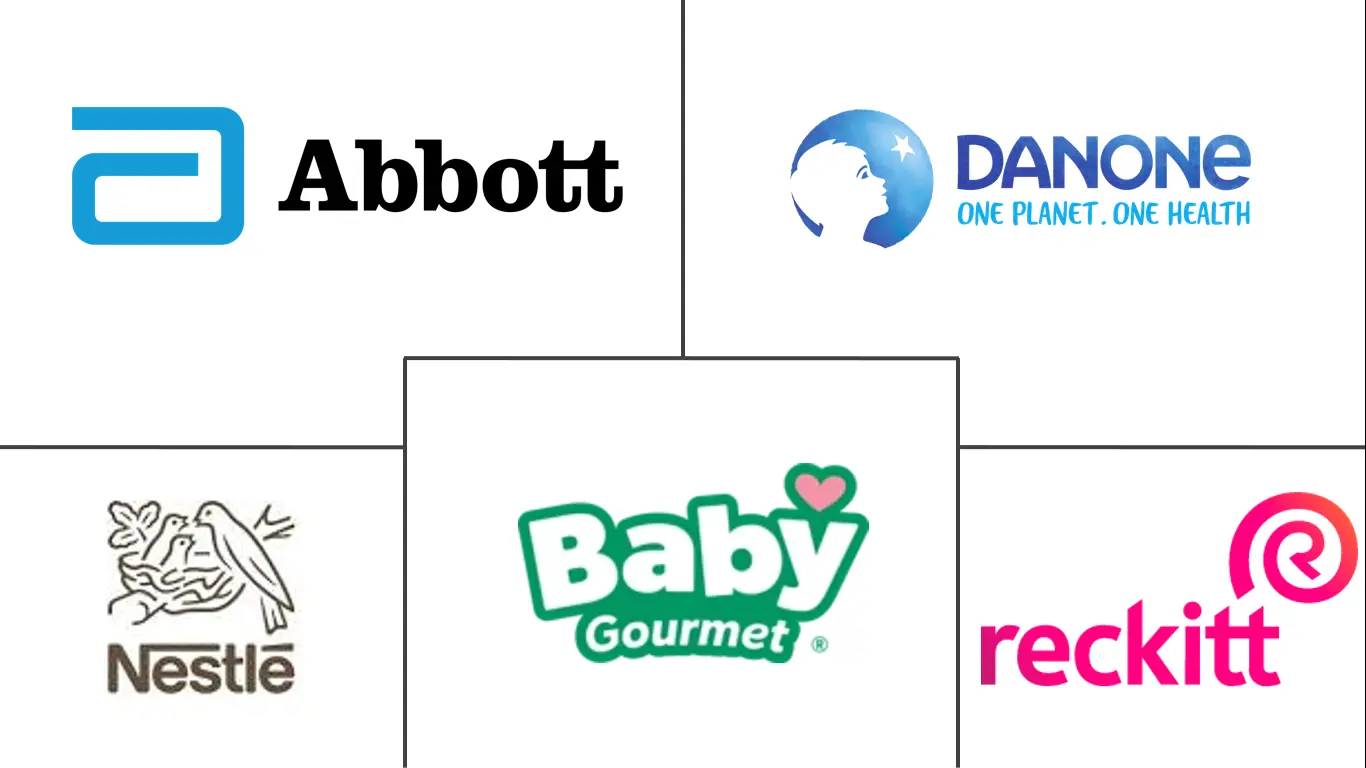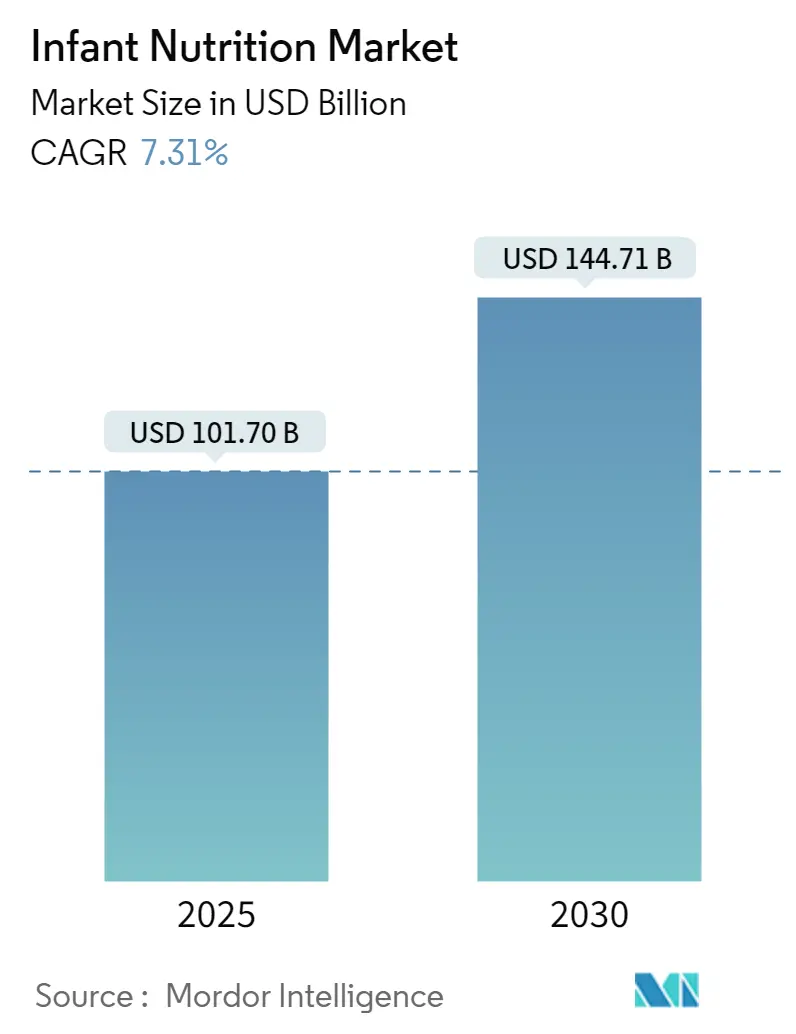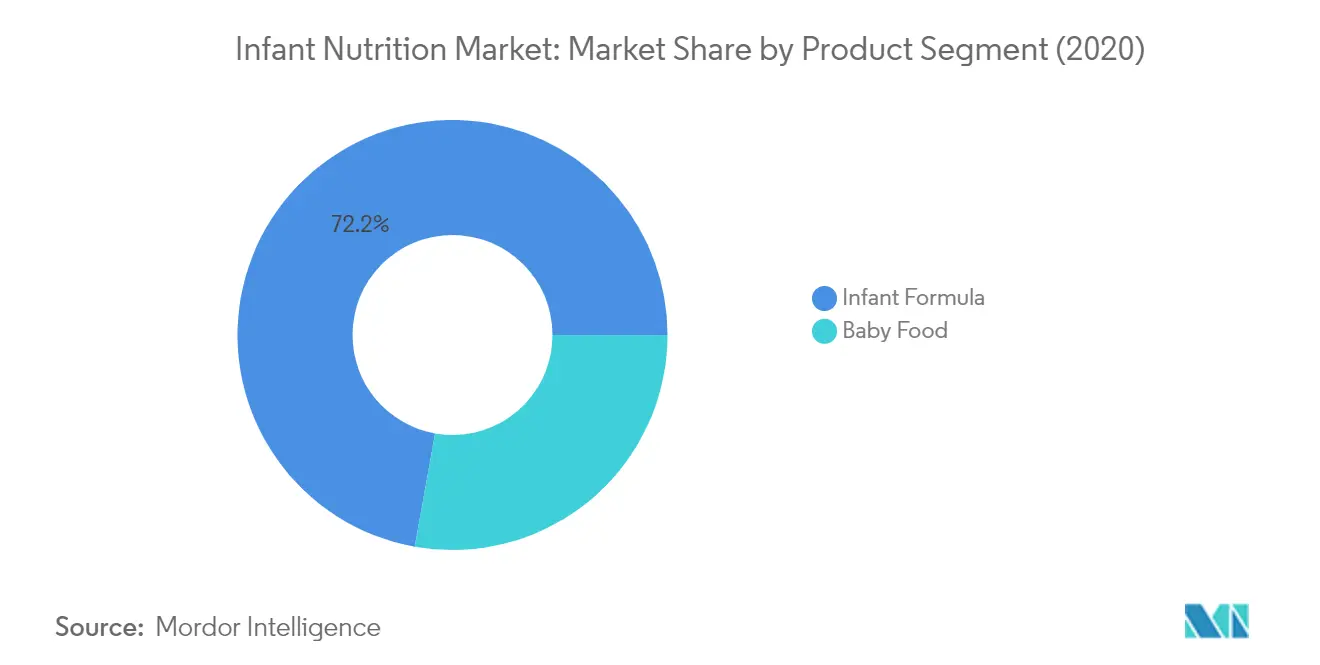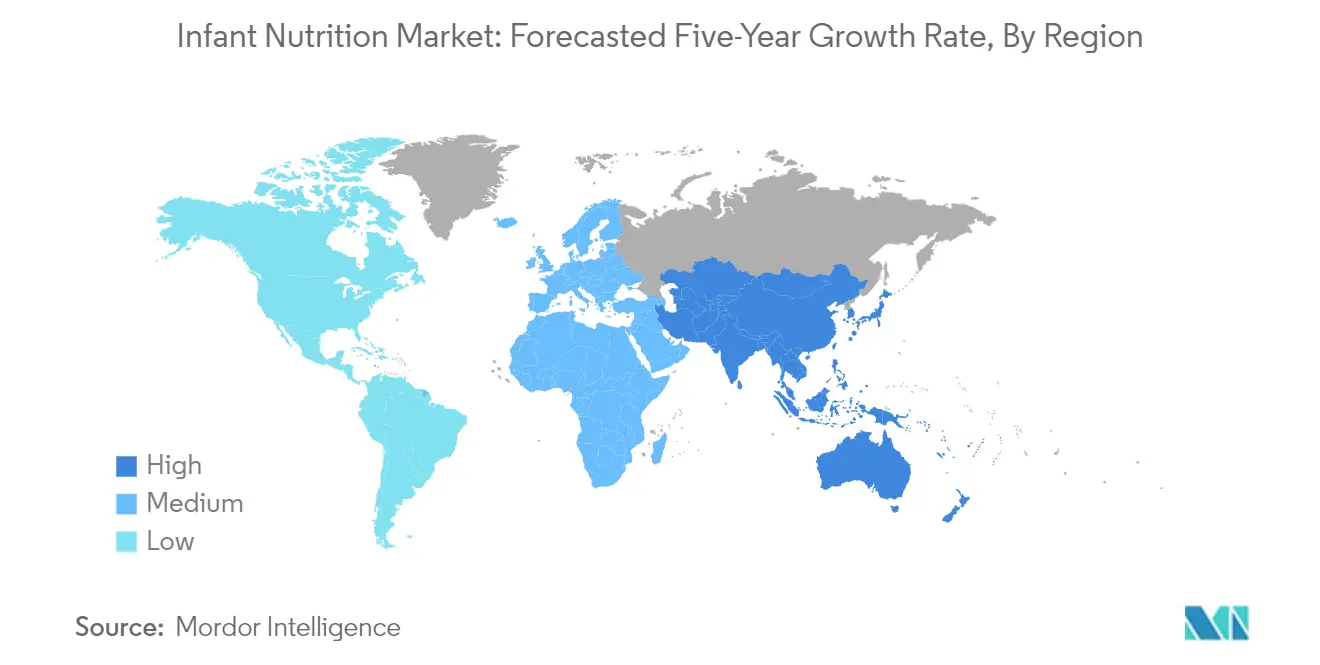Infant Nutrition Market Analysis
The Infant Nutrition Market size is estimated at USD 101.70 billion in 2025, and is expected to reach USD 144.71 billion by 2030, at a CAGR of 7.31% during the forecast period (2025-2030).
The infant nutrition industry continues to evolve rapidly, driven by changing consumer preferences and technological advancements in formulation and manufacturing processes. Manufacturers are increasingly focusing on developing specialized nutrition products that cater to specific dietary requirements and health conditions in infants. The industry has witnessed significant investments in research and development to create innovative ingredients and formulations that closely mirror the nutritional composition of breast milk. This focus on product innovation has led to the emergence of new categories like hypoallergenic formulas, prebiotics-enriched products, and specialized formulations for premature infants.
The distribution landscape for infant nutrition products has undergone substantial transformation, with e-commerce emerging as a crucial sales channel. The post-pandemic era has witnessed a notable shift in consumer buying patterns, particularly in tier three and four cities globally, where there has been increased uptake of infant nutrition products through digital platforms. This shift has prompted manufacturers to strengthen their online presence and develop direct-to-consumer channels, while simultaneously maintaining traditional retail partnerships to ensure widespread product availability.
Product safety and regulatory compliance remain paramount in the infant nutrition market, with manufacturers facing increasingly stringent quality control requirements. Companies are investing heavily in advanced manufacturing facilities and quality assurance processes to meet these standards. The industry has also seen a growing emphasis on transparency in ingredient sourcing and manufacturing processes, with companies providing detailed information about their supply chains to build consumer trust. This trend is particularly evident in the premium segment, where consumers are willing to pay more for products with verified quality credentials.
Recent product innovations have significantly shaped the market landscape, as exemplified by Danone's launch of a new dairy and plant blend baby formula in August 2022, responding to the growing consumer demand for plant-based alternatives. Companies are also focusing on sustainable packaging solutions and environmentally conscious manufacturing processes to appeal to environmentally aware parents. The infant formula market has witnessed increased collaboration between manufacturers and research institutions to develop next-generation nutrition products that offer enhanced benefits for infant development and immune system support.
Infant Nutrition Market Trends
INCREASE IN WORKING MOTHER POPULATION
The substantial rise in working mothers globally has emerged as a primary driver for the infant nutrition market, particularly as women increasingly balance professional careers with family responsibilities. According to the Catalyst Organization's latest data from 2021, there were 75,699,000 women aged 16 and above in the United States labor force, representing 56.1% of all women in the population and comprising nearly half (47.0%) of the total labor force. This demographic shift is particularly significant among mothers with young children, as studies indicate that 75% of mothers with children under age 6 worked full time, while the labor force participation rate of mothers with children under 6 years stood at 66.4%.
The growing female workforce participation has fundamentally altered traditional infant feeding patterns, creating a strong demand for convenient and nutritionally complete feeding solutions. Long working hours and workplace commitments make it challenging for many working mothers to maintain exclusive breastfeeding, leading to increased reliance on infant formula products. This trend is particularly pronounced in developed nations, where women's participation in professional and management positions has reached historic highs, with women holding 51.8% of all management, professional, and related occupations. The adoption of convenience-oriented lifestyles among working mothers has made prepared baby food and baby formula increasingly essential, driving sustained market growth across both developed and developing economies.
HIGHER SPENDING ON INFANT HEALTH
The increasing awareness and prioritization of infant health have led to substantially higher healthcare expenditure, directly benefiting the infant nutrition market. Healthcare spending has reached unprecedented levels, with the United States alone recording USD 3.8 trillion in healthcare expenditure, equivalent to USD 11,582 per person. This broader trend in healthcare spending has translated into increased investment in infant nutrition and wellness, with parents showing greater willingness to allocate significant resources to ensure optimal nutrition for their children. The pattern of high healthcare spending is evident across developed nations, with out-of-pocket spending reaching USD 1,238 per capita in the United States, USD 1,805 per capita in Switzerland, and USD 1,020 per capita in Korea.
The investment in infant nutrition is increasingly recognized as crucial for human capital formation, as proper nutrition directly impacts children's growth, cognitive development, school performance, and future productivity. This recognition has led to greater allocation of resources toward infant nutrition, both at the household and institutional levels. Parents are demonstrating increased awareness of the long-term benefits of proper infant nutrition and are willing to invest in high-quality nutritional products. This trend is further supported by healthcare professionals and institutions that emphasize the importance of proper nutrition during the crucial early development stages, leading to sustained growth in the infant nutrition market.
RISING DEMAND FOR ORGANIC BABY FOOD
The growing consumer preference for organic baby food products has emerged as a significant market driver, reflecting increased awareness of food safety and natural ingredients among parents. Organic baby foods, which are produced without synthetic fertilizers or pesticides, are gaining substantial market share as parents become more conscious of the potential impacts of conventional farming methods on infant health. This trend is particularly strong in developed markets, where consumers demonstrate a willingness to pay premium prices for organic products, driven by the perception that these products offer superior safety and nutritional benefits compared to conventional alternatives.
The market response to this growing demand is evident in the increasing number of product innovations and launches in the organic segment. Major manufacturers and new market entrants are expanding their organic product portfolios to meet this growing consumer preference. The trend extends beyond basic organic ingredients to encompass innovative formulations that address specific nutritional needs while maintaining organic certification. This shift is supported by changing consumer preferences, with parents increasingly seeking products that not only provide essential nutrition but also align with their values regarding environmental sustainability and clean label products. The premium positioning of organic baby food products, combined with growing disposable incomes in key markets, has created a sustainable growth trajectory for this segment of the infant nutrition market.
Segment Analysis: By Product
Infant Formula Segment in Infant Nutrition Market
The infant formula segment continues to dominate the global infant nutrition market, holding approximately 72% of the total market share in 2024. This significant market position is driven by several factors, including the increasing number of working mothers globally, higher spending on infant health, and growing awareness about the importance of proper infant nutrition. The segment's strong performance is further supported by continuous product innovations focusing on ingredients that closely mimic breast milk composition, including specialized formulas for various nutritional needs. Major companies are investing heavily in research and development to create advanced formulations with enhanced nutritional profiles, including products fortified with essential nutrients, probiotics, and oligosaccharides. The demand is particularly strong in emerging markets where rising disposable incomes and growing urbanization are driving the adoption of premium infant formula products.
Baby Food Segment in Infant Nutrition Market
The baby food segment is emerging as the fastest-growing category in the infant nutrition market, projected to grow at approximately 7% during the forecast period 2024-2029. This accelerated growth is primarily driven by the increasing demand for organic and natural baby food products, as parents become more conscious about the ingredients in their children's food. The segment is witnessing significant innovation in terms of product formulations, packaging, and convenience features. Manufacturers are focusing on developing clean-label products with minimal processing and no artificial additives, responding to the growing consumer preference for wholesome nutrition. The segment is also benefiting from the expansion of distribution channels, particularly in emerging markets, and the introduction of new product variants catering to different stages of infant development and dietary requirements.
Infant Nutrition Market Geography Segment Analysis
Infant Nutrition Market in North America
The North American infant nutrition market demonstrates robust growth driven by advanced healthcare infrastructure, increasing awareness about infant health, and a rising number of working mothers. The United States leads the regional market with extensive product offerings and strong distribution networks, followed by Mexico and Canada. The region benefits from high healthcare expenditure, stringent quality standards, and continuous product innovations by major manufacturers. Consumer preferences in this region are increasingly shifting towards organic and natural infant nutrition products, while government initiatives and healthcare programs further support market expansion.
Infant Nutrition Market in the United States
The United States dominates the North American infant nutrition market, accounting for approximately 75% of the regional market share in 2024. The country's market leadership is attributed to its robust healthcare infrastructure, higher spending on infant health, and greater government initiatives toward infant nutrition. The market is characterized by a strong presence of leading manufacturers, extensive distribution networks, and increasing consumer awareness about infant nutrition. The country's regulatory framework ensures high-quality standards for infant nutrition products, while the growing trend towards organic and premium products continues to drive market growth.
Infant Nutrition Market in Mexico
Mexico emerges as the fastest-growing market in North America, with a projected growth rate of approximately 7% during 2024-2029. The country's market growth is driven by increasing urbanization, rising disposable income, and growing awareness about infant nutrition among parents. Mexico's healthcare sector has witnessed significant developments in recent years, with an increasing focus on infant health and nutrition. The market is seeing increased penetration of international brands while local manufacturers are also expanding their presence. Rising female workforce participation and modernization of retail infrastructure further contribute to market expansion.
Infant Nutrition Market in Europe
The European infant nutrition market showcases strong growth potential supported by advanced healthcare systems, high consumer awareness, and stringent quality regulations. The region encompasses diverse markets including the United Kingdom, Germany, France, Italy, and Spain, each with distinct consumer preferences and market dynamics. The market benefits from extensive research and development activities, innovative product launches, and strong distribution networks. European consumers show increasing preference for organic and premium infant nutrition products, while manufacturers focus on product innovation and quality enhancement.
Infant Nutrition Market in the United Kingdom
The United Kingdom maintains its position as the largest infant nutrition market in Europe, representing approximately 12% of the regional market share in 2024. The country's market leadership is supported by high consumer spending on infant nutrition, a strong presence of major manufacturers, and well-established distribution channels. The UK market is characterized by increasing demand for premium and organic products, while regulatory frameworks ensure high-quality standards. Rising awareness about infant nutrition and health among parents continues to drive market growth.
Infant Nutrition Market in France
France demonstrates the highest growth potential in the European region, with an expected growth rate of approximately 7% during 2024-2029. The French market is characterized by a strong emphasis on product quality, innovation, and safety standards. The country's robust healthcare system and government support for infant nutrition programs contribute significantly to market growth. French consumers show increasing preference for organic and natural ingredients, while manufacturers focus on product development aligned with local preferences and nutritional guidelines.
Infant Nutrition Market in Asia-Pacific
The Asia-Pacific infant nutrition market represents a dynamic and rapidly evolving landscape, encompassing diverse markets including China, Japan, India, Australia, and South Korea. The region demonstrates significant growth potential driven by increasing urbanization, rising disposable incomes, and growing awareness about infant nutrition. Each country in the region presents unique opportunities and challenges, influenced by local preferences, regulatory frameworks, and economic conditions. The market is characterized by intense competition among both international and local players.
Infant Nutrition Market in China
China maintains its position as the dominant force in the Asia-Pacific infant nutrition market. The Chinese market benefits from a large consumer base, increasing urbanization, and rising disposable incomes. The country's market is characterized by strong domestic manufacturing capabilities, extensive distribution networks, and an increasing focus on product quality and safety. Government initiatives promoting infant health and nutrition, coupled with changing consumer preferences towards premium products, continue to drive market growth.
Infant Nutrition Market in India
India emerges as the fastest-growing market in the Asia-Pacific region. The Indian market demonstrates significant growth potential driven by increasing awareness about infant nutrition, rising disposable incomes, and growing urbanization. The country's large young population and increasing female workforce participation contribute to market expansion. The market is witnessing increased penetration of international brands while local manufacturers are also strengthening their presence through product innovations and expanded distribution networks.
Infant Nutrition Market in Middle East & Africa
The Middle East & Africa infant nutrition market demonstrates significant growth potential, encompassing diverse markets including GCC countries and South Africa. The region's market is driven by increasing healthcare expenditure, rising awareness about infant nutrition, and growing urbanization. Among the countries, GCC emerges as the largest market while also showing the fastest growth rate, supported by high disposable incomes and strong healthcare infrastructure. The market benefits from government initiatives promoting infant health and nutrition, while manufacturers focus on product innovations aligned with regional preferences.
Infant Nutrition Market in South America
The South American infant nutrition market, led by Brazil and Argentina, shows promising growth potential driven by increasing healthcare awareness and rising disposable incomes. Brazil emerges as both the largest and fastest-growing market in the region, supported by its large population base and improving economic conditions. The market is characterized by increasing penetration of international brands while local manufacturers also maintain a strong presence. Government initiatives promoting infant health and nutrition, coupled with rising urbanization and female workforce participation, continue to drive market growth across the region.
Infant Nutrition Industry Overview
Top Companies in Infant Nutrition Market
The infant nutrition market features prominent players like Abbott, Nestlé, Danone, FrieslandCampina, and Reckitt Benckiser leading global innovation and market development. These infant nutrition companies are increasingly focusing on organic product development and clean-label solutions to meet growing consumer demand for natural ingredients. Strategic moves include significant investments in research and development of specialized formulations, particularly in areas like human milk oligosaccharides (HMO) and personalized nutrition solutions. Companies are strengthening their distribution networks through an omnichannel presence, combining traditional retail with e-commerce platforms and direct-to-consumer models. Operational agility is demonstrated through supply chain optimization, manufacturing facility upgrades, and strategic partnerships with local players in emerging markets. Product innovation trends show a clear shift towards functional ingredients, organic certifications, and specialized formulations for different developmental stages and dietary requirements.
Consolidated Market with Strong Regional Players
The infant formula industry exhibits a highly consolidated structure where multinational conglomerates dominate the global landscape while maintaining strong regional positions through local subsidiaries and partnerships. These major players leverage their extensive research capabilities, established distribution networks, and brand equity to maintain market leadership. The market is characterized by a mix of global giants with diverse product portfolios and specialized regional players focusing on specific market segments or geographical areas. Merger and acquisition activities are primarily focused on expanding geographical presence, acquiring innovative technologies, and strengthening positions in emerging markets.
The competitive dynamics vary significantly across regions, with developed markets showing higher consolidation and emerging markets featuring a more fragmented structure with strong local players. Companies are increasingly pursuing strategic collaborations with local manufacturers and distributors to penetrate new markets and adapt to regional preferences. The industry has witnessed several strategic acquisitions aimed at expanding product portfolios, particularly in specialized nutrition segments and organic offerings. Market leaders are also investing in backward integration through partnerships with dairy suppliers and research institutions to ensure product quality and innovation capabilities.
Innovation and Adaptability Drive Market Success
Success in the infant formula market increasingly depends on companies' ability to innovate while maintaining stringent quality standards and regulatory compliance. Incumbent players must focus on continuous product innovation, particularly in areas like organic ingredients, specialized formulations, and clean-label products to maintain their market position. Building strong relationships with healthcare professionals and maintaining transparency in product development and manufacturing processes are becoming crucial for market success. Companies need to invest in digital capabilities to enhance consumer engagement and provide personalized nutrition solutions while expanding their distribution networks to reach underserved markets.
For contenders looking to gain market share, differentiation through specialized product offerings and a focus on specific market segments or geographical regions presents significant opportunities. Success factors include developing strong local manufacturing capabilities, establishing reliable supply chains, and building trust through scientific validation of product benefits. The regulatory landscape continues to evolve, particularly regarding ingredient specifications and health claims, requiring companies to maintain robust compliance frameworks. Market players must also address the growing influence of healthcare professionals and increasing consumer awareness about infant nutrition products while managing the relatively low threat of substitution due to the essential nature of infant nutrition products.
Infant Nutrition Market Leaders
-
Abbott Laboratories
-
BABY GOURMET
-
Danone S.A.
-
Reckitt Benckiser Group PLC.
-
Nestle
- *Disclaimer: Major Players sorted in no particular order
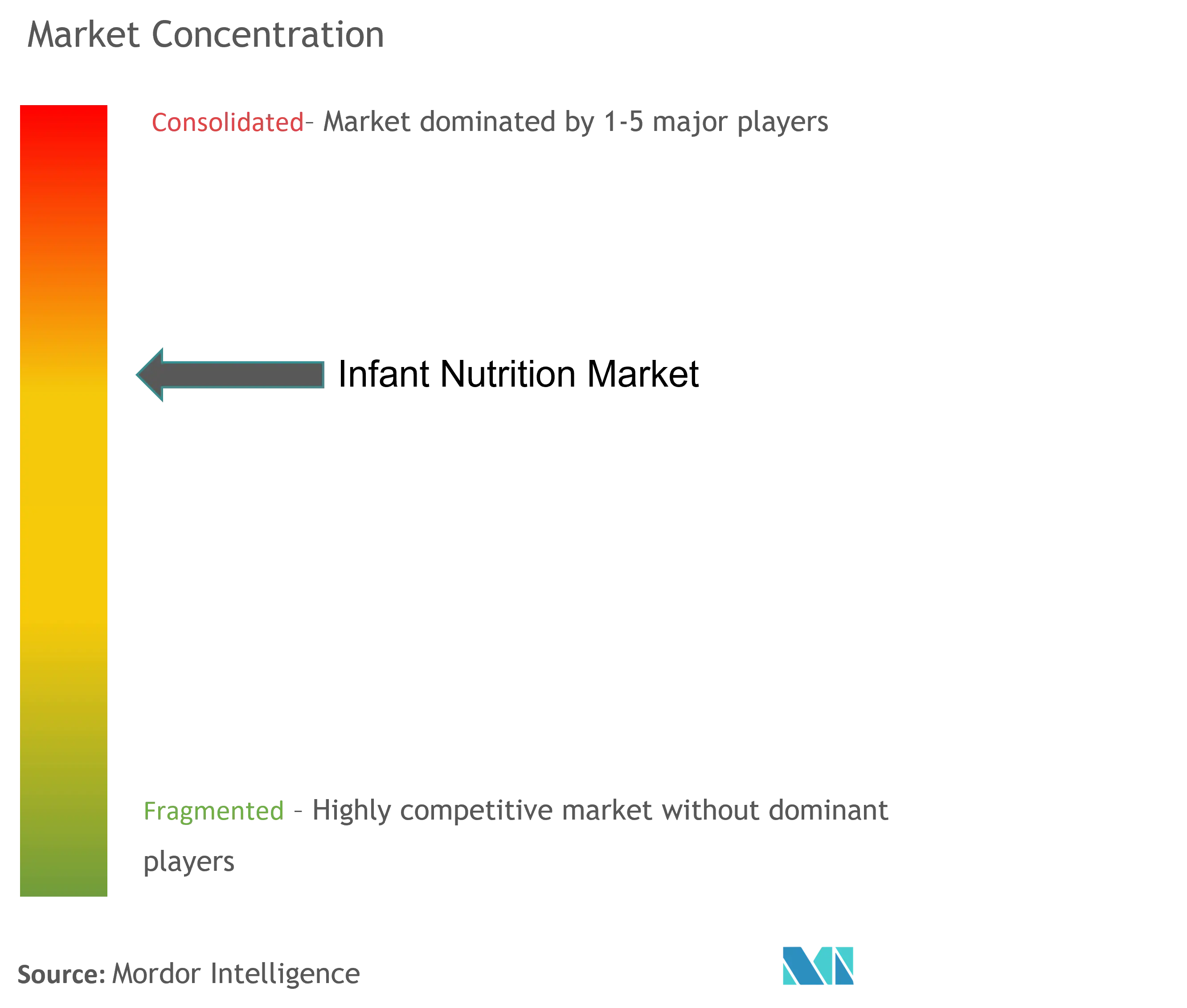
Infant Nutrition Market News
- In October 2022, Else Nutrition Holdings Inc. launched its flagship Chinese store on Tmall Global in September and is now selling Else Nutrition Toddler Formula and Baby Cereal products directly to Chinese consumers through the store. The opening of the Chinese market is the third market for Else in its international expansion.
- In September 2022, Nestlé identified a nutrient blend of components found in breast milk, myelin, and launched Nutrilearn Connect, an infant formula containing the novel ingredient, in Hong Kong before expanding to other markets.
Infant Nutrition Market Report - Table of Contents
1. INTRODUCTION
- 1.1 Study Assumptions and Market Definition
- 1.2 Scope of the Study
2. RESEARCH METHODOLOGY
3. EXECUTIVE SUMMARY
4. MARKET DYNAMICS
- 4.1 Market Overview
-
4.2 Market Drivers
- 4.2.1 Increase in Working Mother Population
- 4.2.2 Higher Spending on Infant Health
- 4.2.3 Rising Demand for Organic Baby Food
-
4.3 Market Restraints
- 4.3.1 Concerns Regarding Food Safety
- 4.3.2 Stringent Regulations for Infant Food
-
4.4 Industry Attractiveness - Porter's Five Forces Analysis
- 4.4.1 Threat of New Entrants
- 4.4.2 Bargaining Power of Buyers/Consumers
- 4.4.3 Bargaining Power of Suppliers
- 4.4.4 Threat of Substitute Products
- 4.4.5 Intensity of Competitive Rivalry
5. MARKET SEGMENTATION (Market Size by Value - USD million)
-
5.1 By Product
- 5.1.1 Infant Formula
- 5.1.1.1 First Infant Formula
- 5.1.1.2 Follow-on Formula
- 5.1.1.3 Growing-up Formula
- 5.1.1.4 Specialty Baby Formula
- 5.1.2 Baby Food
- 5.1.2.1 Prepared Food
- 5.1.2.2 Dried Food
- 5.1.2.3 Other Baby Foods
-
5.2 Geography
- 5.2.1 North America
- 5.2.1.1 United States
- 5.2.1.2 Canada
- 5.2.1.3 Mexico
- 5.2.2 Europe
- 5.2.2.1 Germany
- 5.2.2.2 United Kingdom
- 5.2.2.3 France
- 5.2.2.4 Italy
- 5.2.2.5 Spain
- 5.2.2.6 Rest of Europe
- 5.2.3 Asia-Pacific
- 5.2.3.1 China
- 5.2.3.2 Japan
- 5.2.3.3 India
- 5.2.3.4 Australia
- 5.2.3.5 South Korea
- 5.2.3.6 Rest of Asia Pacific
- 5.2.4 Middle East & Africa
- 5.2.4.1 GCC
- 5.2.4.2 South Africa
- 5.2.4.3 Rest of Middle East & Africa
- 5.2.5 South America
- 5.2.5.1 Brazil
- 5.2.5.2 Argentina
- 5.2.5.3 Rest of South America
6. COMPETITIVE LANDSCAPE
-
6.1 Company Profiles
- 6.1.1 Abbott Laboratories
- 6.1.2 Baby Gourmet Foods Inc.
- 6.1.3 Bellamy's Australia Limited
- 6.1.4 Danone SA
- 6.1.5 Royal FrieslandCampina NV
- 6.1.6 Reckitt Benckiser (Mead Johnson)
- 6.1.7 Nestlé SA
- 6.1.8 Perrigo Company PLC
- 6.1.9 Parent's Choice Infant Formula
- 6.1.10 The Kraft Heinz Company
- 6.1.11 Meiji Holdings
- 6.1.12 Synutra International Inc.
- 6.1.13 Dana Dairy Group Ltd
- *List Not Exhaustive
7. MARKET OPPORTUNITIES AND FUTURE TRENDS
Infant Nutrition Industry Segmentation
As per the scope of the report, infant nutrition is a substitute for breast milk. The initial six months after birth play a crucial role in the development of a child, and ensuring optimal nutrition during this period is of paramount importance. Breast milk is highly nutritious and contains carbohydrates, proteins, fats, minerals, and vitamins that are imperative for the child's development. However, in some instances, the mother may not be able to produce breast milk or may not be able to breastfeed the baby due to other reasons. In such cases, infant nutrition products act as a suitable substitute. The Infant Nutrition Market is segmented by Product (Infant Formula, and Baby Food) and Geography (North America, Europe, Asia-Pacific, Middle East & Africa, and South America). The market report also covers the estimated infant formula market size and trends for 17 different countries across major regions globally. The report offers the value (in USD million) for the above-mentioned segments.
| By Product | Infant Formula | First Infant Formula | |
| Follow-on Formula | |||
| Growing-up Formula | |||
| Specialty Baby Formula | |||
| Baby Food | Prepared Food | ||
| Dried Food | |||
| Other Baby Foods | |||
| Geography | North America | United States | |
| Canada | |||
| Mexico | |||
| Europe | Germany | ||
| United Kingdom | |||
| France | |||
| Italy | |||
| Spain | |||
| Rest of Europe | |||
| Asia-Pacific | China | ||
| Japan | |||
| India | |||
| Australia | |||
| South Korea | |||
| Rest of Asia Pacific | |||
| Middle East & Africa | GCC | ||
| South Africa | |||
| Rest of Middle East & Africa | |||
| South America | Brazil | ||
| Argentina | |||
| Rest of South America | |||
Infant Nutrition Market Research FAQs
How big is the Infant Nutrition Market?
The Infant Nutrition Market size is expected to reach USD 101.70 billion in 2025 and grow at a CAGR of 7.31% to reach USD 144.71 billion by 2030.
What is the current Infant Nutrition Market size?
In 2025, the Infant Nutrition Market size is expected to reach USD 101.70 billion.
Who are the key players in Infant Nutrition Market?
Abbott Laboratories, BABY GOURMET, Danone S.A., Reckitt Benckiser Group PLC. and Nestle are the major companies operating in the Infant Nutrition Market.
Which is the fastest growing region in Infant Nutrition Market?
North America is estimated to grow at the highest CAGR over the forecast period (2025-2030).
Which region has the biggest share in Infant Nutrition Market?
In 2025, the Asia Pacific accounts for the largest market share in Infant Nutrition Market.
What years does this Infant Nutrition Market cover, and what was the market size in 2024?
In 2024, the Infant Nutrition Market size was estimated at USD 94.27 billion. The report covers the Infant Nutrition Market historical market size for years: 2021, 2022, 2023 and 2024. The report also forecasts the Infant Nutrition Market size for years: 2025, 2026, 2027, 2028, 2029 and 2030.
Our Best Selling Reports
Infant Nutrition Market Research
Mordor Intelligence provides a comprehensive analysis of the infant nutrition market. We leverage decades of expertise in the infant formula industry analysis and market research consulting. Our extensive report covers the complete spectrum of infant nutrition products, including baby formula, infant food, and specialized pediatric nutrition solutions. The analysis includes detailed insights into infant formula ingredients, market dynamics, and emerging trends in the infant nutrition industry.
Stakeholders gain valuable insights through our detailed examination of infant nutrition market size projections and growth indicators. The report, available as an easy-to-download PDF, provides an in-depth analysis of leading infant nutrition companies and their strategic initiatives. Our research includes comprehensive coverage of nutritional requirements for infants, novel infant formula developments, and emerging opportunities in the infant formula market. This delivers actionable intelligence for industry participants, investors, and decision-makers.

